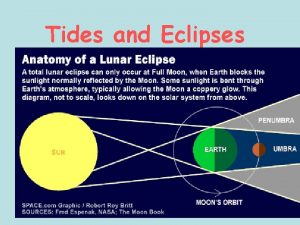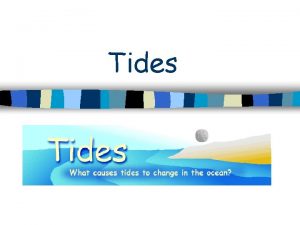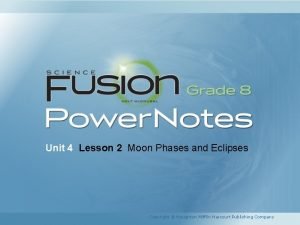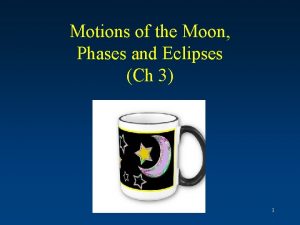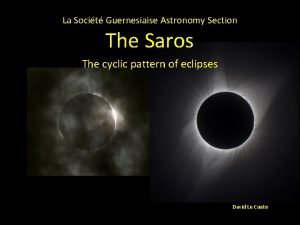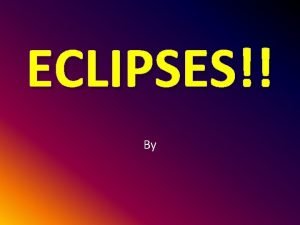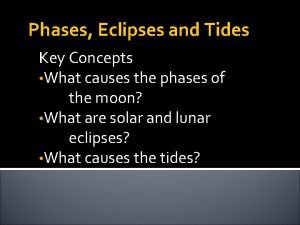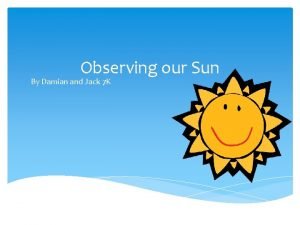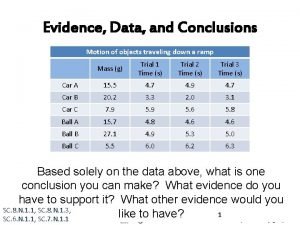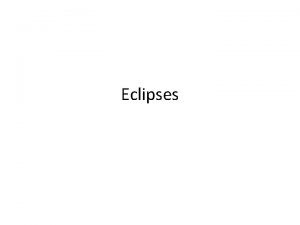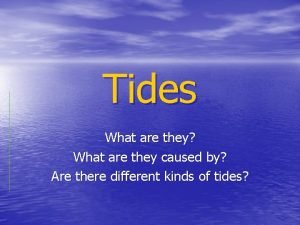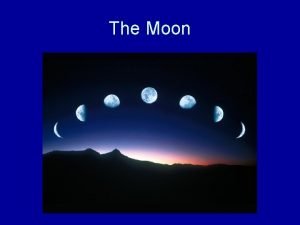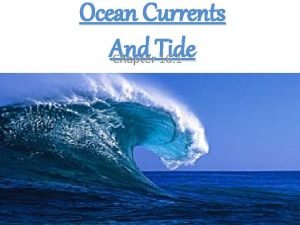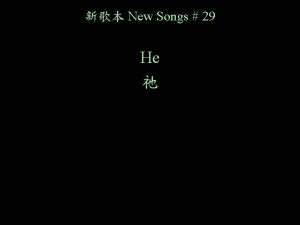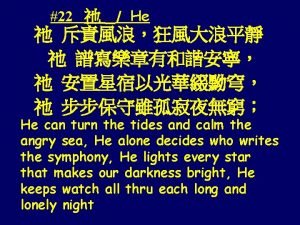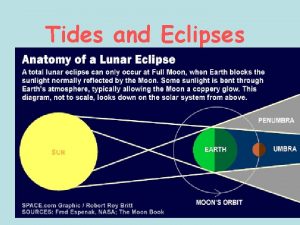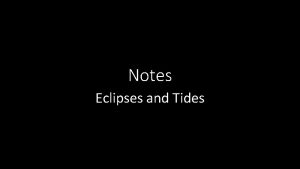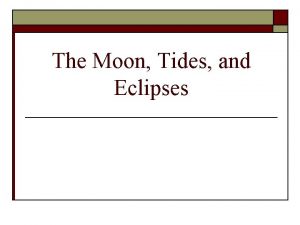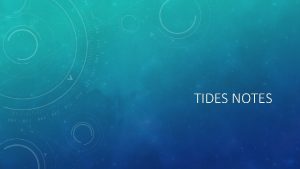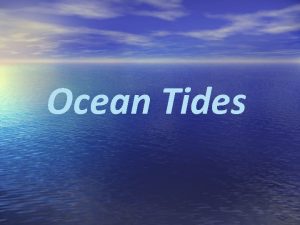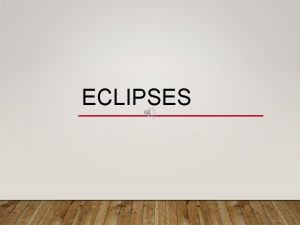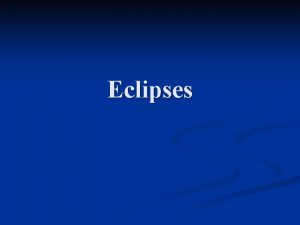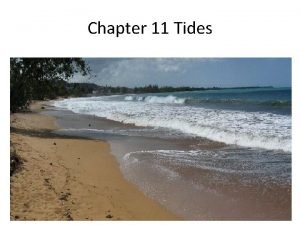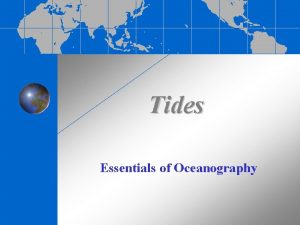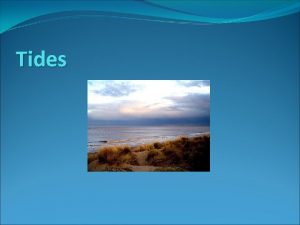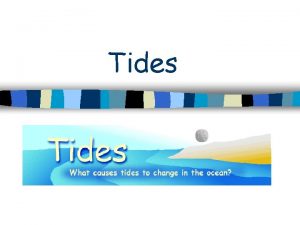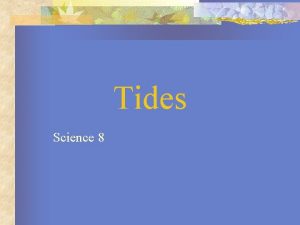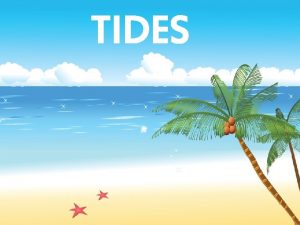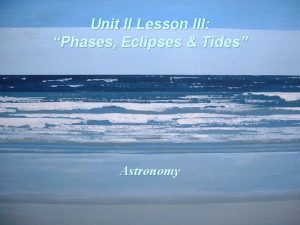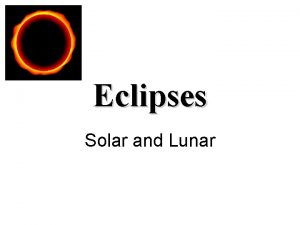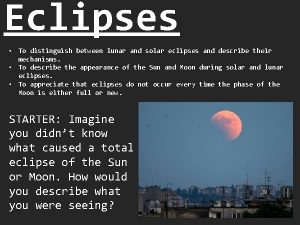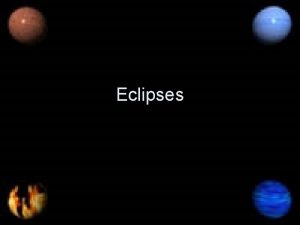Eclipses and Tides 6 TH GRADE ASTRONOMY Eclipses



























- Slides: 27

Eclipses and Tides 6 TH GRADE ASTRONOMY

Eclipses �When the moon’s shadow hits the Earth or Earth’s shadow hits the moon, an eclipse occurs. �There are two types of eclipses: solar and lunar. (solar and lunar come from the Latin words for “sun” and “moon. ”) �A solar eclipse occurs when the moon passes directly between Earth and the sun, blocking sunlight from Earth. This happens during the new moon phase. �A solar eclipse occurs when the new moon blocks our view of the sun.

Eclipses �The very darkest of the moon’s shadow, the umbra is cone-shaped. �From any point in the umbra, light from the sun is completely blocked. �Only the people in the umbra experience a total solar eclipse. �The larger part of the shadow is the penumbra. In the penumbra, part of the sun is visible from Earth. �During a solar eclipse, people in the penumbra see only a partial eclipse.


http: //www. youtube. com/watch? v=K 42 Uq WGd. A_o http: //kottke. org/10/07/total-solar-eclipse -video

Lunar Eclipse �A lunar eclipse occurs at a full moon when the Earth is directly between the moon and the sun. �During a lunar eclipse the Earth blocks the sunlight from reaching the moon. �Only during a full moon, because the moon is closest to Earth’s shadow at that time. �Like the moon’s shadow during a solar eclipse, Earth’s shadow has an umbra and penumbra. �Unlike a total solar eclipse, a total lunar eclipse can be seen anywhere on Earth. �A partial lunar eclipse occurs when the moon passes partly into the umbra of Earth’s shadow.



Past Eclipses �During the 20 th century 375 eclipses have taken or will take place: 228 solar and 147 lunar. The last total eclipse of the sun visible in the U. S. in this century occurred over the state of Hawaii on July 11, 1991. The prior such eclipse occurred over the state of Washington on Feb. 26, 1979. The next total eclipse will be visible from the U. S. in 2017.

Tides � Tides- the rise and fall of ocean water that occurs every 12. 5 hours. � The water rises for about 6 hours, then falls for about 6 hours. � Tides are caused mainly by differences in how much the moon’s gravity pulls on different parts of the Earth. � At any one time there are two high tides and two places with low tides on Earth. � As Earth rotates, one high tide stays on the side of Earth facing the moon. The second high tide is on the opposite side of Earth. � Each location on Earth sweeps through those tides every 25 hours.






Spring Tides � The sun’s gravity also pulls on Earth’s waters. � The sun, moon, and Earth are nearly in a line during a new moon. � The gravity of the sun and moon pull in the same direction. � Their combined forces produce a spring tide. � This tide has the greatest difference between high and low. � At a full moon the sun and moon are on opposite sides of the Earth. � This also causes a spring tide. � It doesn’t matter the order in which they line up. � Spring tides occur twice a month, at new moon and at full moon.


Neap Tides �During the moon’s first quarter and third-quarter phases, the line between Earth and the sun are at right angles to the line between Earth and the moon. The sun’s pull is at right angles to the moons pull. �They are pulling in different directions, producing the least difference between low and high tides. �Neap tides occur twice a month.


Gravity • A force is a push or pull. • Newton hypothesized that the force that pulls an apple to the ground also pulls the moon toward the Earth, keeping it in orbit. • This force is called gravity. • Newton’s law of universal gravitation states that every object in the universe attracts every other object. • The force of gravity is measured in units called Newton. • The strength of the force of gravity between two objects depends on two factors: the masses of the objects and the distance between them.

The Moon’s Features

Earth’s Moon �The Greeks thought the moon was perfectly smooth. � 1609 - Galileo Galilei made his own telescope by putting two lenses in a wooden tube. �He was able to see details of the moon, that had never been seen before. �Features of the moon include- maria, craters, and highlands.


The moon’s surface �The moon’s surface has dark, flat areas, which Ga. Iileo called maria, the Latin word for “seas. ” Galileo thought the maria were oceans. He was wrong. �The maria are hardened rock formed from lava flows that occurred between 3 -4 billion years ago. �The moon has many craters covering the surface. �Some craters are hundreds of kilometers across.

Moon’s Surface �A long time ago scientist thought volcanoes caused these craters. �Today they know that meteoroids hitting the surface caused these holes. Meteoroids are chunks of rock or dusk from space. �On Earth our craters have been worn away over time by water, wind and other forces. �Since the moon has no liquid water or atmosphere, its surface has changed very little over billions of years.

Moon’s surface cont… �Galileo correctly guessed that some of the light colored features of the moon were highlands, or mountains. The peaks of the highlands and the rims of the craters cast dark shadows. �The rugged lunar highlands cover much of the moon’s surface.

 Tides and eclipses
Tides and eclipses The sun-earth-moon system worksheet answers lesson 1
The sun-earth-moon system worksheet answers lesson 1 Eclipses and tides lesson 3
Eclipses and tides lesson 3 Spring tide position
Spring tide position The difference between spring tides and neap tides
The difference between spring tides and neap tides Learning astronomy by doing astronomy activity 1 answers
Learning astronomy by doing astronomy activity 1 answers Learning astronomy by doing astronomy activity 1 answers
Learning astronomy by doing astronomy activity 1 answers Learning astronomy by doing astronomy
Learning astronomy by doing astronomy Lesson 2 moon phases and eclipses answer key
Lesson 2 moon phases and eclipses answer key New moon facts
New moon facts Moon phases and eclipses
Moon phases and eclipses The two eclipses
The two eclipses The two eclipses
The two eclipses Ano ang pagkakaiba ng solar at lunar eclipse
Ano ang pagkakaiba ng solar at lunar eclipse Eclipse tide
Eclipse tide Why is the sun so important
Why is the sun so important Mapa conceptual del sonido y sus características
Mapa conceptual del sonido y sus características Eclipses
Eclipses Brainpop eclipse
Brainpop eclipse What are tides and how are they caused
What are tides and how are they caused A person standing in the moon's penumbra will see a
A person standing in the moon's penumbra will see a Ocean currents waves and tides
Ocean currents waves and tides Spring tide vs neap tide
Spring tide vs neap tide Shifting tides timeline and map
Shifting tides timeline and map Shifting tides timeline and map
Shifting tides timeline and map Shifting tides timeline and map
Shifting tides timeline and map He can turn the tide and calm the angry sea
He can turn the tide and calm the angry sea He can turn the tides and calm the angry sea
He can turn the tides and calm the angry sea
